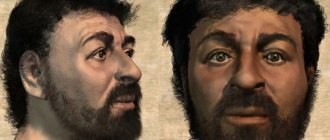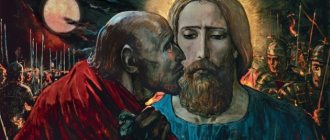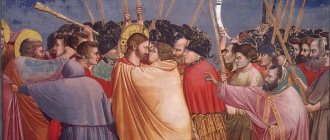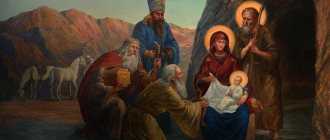For the beginning Christian
Published 11/15/2017
So why did Judas Iscariot betray Jesus Christ ? The name Judas has been associated with betrayal for many centuries and has become a household name. Judas is not mentioned many times in the Bible, but his reasons for betraying Jesus are well described. Let's figure it out.
Life story
In official sources, the life of Judas is devoid of detailed details. In the Bible, this is one of the 12 apostles of Jesus, and he is also entrusted with the mission of treasurer of a small community. The hero received a responsible position for his frugality and ability to refuse useless and unreasonable spending of money. The canonical documents describe the moment when Judas reproaches Mary of Bethany for anointing Jesus' feet with ointment worth 300 denarii. The money is serious, it would be enough to feed a lot of beggars.
Judas Iscariot
The next time the character appears is during the Last Supper: Judas and other disciples of Jesus are having dinner at a common table, and the teacher prophesies betrayal on the part of one of those present.
Non-canonical sources are more generous with details of the traitor's biography. Judas was born on April 1 (since then the day has been considered the most unlucky of the year). The child was unlucky from the very beginning: before birth, the mother had a terrible dream, which warned that the newborn son would destroy the family.
Judas Iscariot and Jesus Christ
Therefore, the parents decided to throw the baby in the ark into the river. But Judas remained alive and unharmed, ended up on the island of Kariof, and when he grew up and matured, he returned to his native land. He fulfilled a terrible prophecy - he killed his father and entered into an incestuous relationship with his mother.
Then Judas received his sight and repented. To atone for his sins, for 33 years he took water into his mouth every day, climbed the mountain and watered a dried stick. A miracle happened - the dead plant produced new leaves, and Judas became a disciple of Jesus.
Other apocrypha states that the hero lived next door to Jesus from childhood. The sick boy was treated by a minor healer, but during the procedure he was possessed by a demon, so Judas bit Jesus on the side. The remaining scar was later hit by a Roman legionnaire's spear. Some legends even talk about the relationship between Judas and Jesus - the characters are even called brothers.
Judas Iscariot among the 12 apostles
There is no consensus on the meaning of the nickname “Iscariot”. The son of Simon ish Karioth, Judas (although his father’s name is not directly named) received a second name to distinguish him from his namesake, another disciple of Jesus. Iscariot appeared as an altered name for the homeland - the only hero of all the apostles was born in the city of Kariot (or Karioth), the rest were natives of Galilee.
Some researchers suggest that the word "keriyot" simply means "suburb", a village near Jerusalem. Others see an analogy with Greek and Aramaic words that are translated as “deceitful,” “murderer,” “armed with a dagger.”
Judas Iscariot plots betrayal
The image of Judas was formed from descriptions of the ancient apocrypha. The character is presented as a short and dark man with dark hair, extremely fussy, loving silver (the treasurer often stole from the cash drawer).
In the Gospel, hair color is not indicated; writers endowed this feature of the hero’s appearance. And later the opinion took root that Judas was red-haired. For example, Emile Zola and Honore de Balzac used the expression “red-haired like Judas” in their works. The apostle wore clothes made of white fabric, which were always decorated with a leather apron with pockets. In Islam, Judas looks like Jesus - Allah made sure that he was crucified instead of the Messiah.
Icon of Judas Iscariot
The death of Judas is accurately described in the Bible, although in two versions. Having betrayed his teacher, the treasurer went and hanged himself. Legend has it that the man chose aspen for these purposes. It was from then on that the leaves of the trees began to tremble in the wind, and the plant itself acquired amazing properties. Aspen wood makes an excellent weapon against evil spirits (vampires); housing cannot be built from it, only outbuildings.
The second canonical version states:
“...and when he fell, his belly was split open, and all his entrails fell out.”
The priests do not see a contradiction here, believing that the rope on which Judas hanged himself broke and he “fell down.” According to some sources, the traitor of Jesus died in old age from an unknown incurable disease.
Etymology
Judas
(
Yehuda
) -
praising the Lord
, “
praise
or
glorified
.”
Iscariot
(Hebrew אִישׁ־קְרִיּוֹת,
ish-keriyot
, where Hebrew אִישׁ -
person, husband
; Hebrew קְרִיּוֹת -
cities, settlements, ker jof, keriofa, kiriath
).
- “ man from Kariot
”, based on his place of birth in the city of Kariot (Karioth) - perhaps identical to the city of Kariot in Judea, in connection with which there is a point of view according to which Judas Iscariot belonged to the tribe of Judah and was the only disciple of Jesus from this tribe , the rest of the disciples were Jews from Galilee. - According to another theory, since the word “keriyot” means suburb, then “Ish-Keriyot” is literally translated as “resident of the suburbs,” which is very likely, since Jerusalem at that time was a fairly large city, and there were many small villages near it, which and were called "krayot"
- Sometimes the meaning of a word is derived from Aram. ish karia "deceitful", or from the Greek root. σκαρ equal to Hebrew-Aramaic. sqr "to paint" (Iscariot - "dyer").
- Or Iscariot is a corruption of the Greek. σικάριος (“sicarius”; “armed with a dagger”, “assassin”), as the Zealots - participants in the liberation struggle against Roman rule in Judea - were sometimes called.
Judas received the nickname “Iscariot” among the apostles to distinguish him from another disciple of Christ, Judas, son of Jacob, nicknamed Thaddeus.
Of the evangelists, only John calls Judas Simon four times. John does not directly call the apostle the son of Simon, which means that Simon could appear to Judas as an older brother if Iscariot’s father died prematurely.
Betrayal of Judas
Having conceived betrayal, Judas went to the high priests and asked what price he would receive for his act. The apostle was promised 30 pieces of silver for his “work.” According to the canonical idea, this is a decent amount: plots of land in the city were sold for this price. A convenient opportunity to surrender Christ presented itself that same night. The man led soldiers to the Garden of Gethsemane, where he pointed to the teacher with a kiss, first explaining:
“Whomever I kiss is He, take Him.”
According to Archbishop Theophylact of Bulgaria, Judas kissed Jesus so that the soldiers would not confuse him with the apostles, because it was a dark night outside.
Kiss of Judas
New Testament researchers also explain why this particular method of indicating the Messiah was chosen - this is a traditional sign of greeting, a wish for peace and goodness among the Jews. Over time, the phrase “kiss of Judas” has become an idiom that denotes the highest degree of deceit. Once Christ is sentenced to crucifixion, Judas realizes what he has done and repents. Returns thirty pieces of silver with the words
“I have sinned by betraying innocent blood,”
and in response he hears:
“What do we care about that? Take a look yourself".
Dozens of minds took on the topic of why Judas betrayed Christ. One of the most obvious explanations is greed. Evangelists also point to the participation of Satan: he allegedly possessed the treasurer and controlled the actions.
Painting “Judas Iscariot Throwing Silver Pieces”, Platon Vasiliev
Some representatives of the church claim the inevitability of God's providence, saying that the events were planned from above, and Jesus knew about it. Moreover, he asked the apostle to give him up, and since the student was unable to disobey the teacher, he had to obey. Thus, Judas turns into a victim, and instead of hell, the hero will be in heaven.
Some try to justify the act by saying that Judas was tired of waiting for Jesus to finally reveal his glory and mission, while still hoping for the miraculous salvation of his teacher. Others went further, accusing Judas of being disillusioned with Jesus, mistaking him for a false Messiah, and acting in the name of the triumph of truth.
Quotes
“Christ is one for all eras. There are hundreds of Judas in each one.”
“It would be good for the whole world, especially for the children of God, if Judas remained alone in his crime, so that there were no more traitors besides him.”
Janusz Ros, Polish satirist:
“Only one Judas for the twelve apostles? Hard to believe!"
Vasily Klyuchevsky, historian:
“Christs rarely appear like comets, but Judases are not translated like mosquitoes.”
Paul Valéry, French poet:
“Never judge a person by his friends. Judas’s were perfect.”
Wieslaw Brudzinski, Polish satirist:
“Beginner Judas puts a lot of sincere feeling into his kiss.”
Oscar Wilde, English writer:
“Today every great man has disciples, and his biography is usually written by Judas.”
In culture
Dozens of writers have tried to interpret the image of the biblical Judas in their own way. In the mid-19th century, Italian journalist Ferdinando Gattina published the book “Memoirs of Judas,” which outraged the religious community - the traitor was exposed as a fighter for the freedom of the Jewish people.
Leonid Andreev's novel “Judas Iscariot”
Alexey Remizov, Jorge Luis Borges, and Roman Redlikh rethought the hero’s life. Leonid Andreev shared an interesting view of the acts of Judas Iscariot in his book of the same name. The representative of the Silver Age showed a traitor who in his soul endlessly loved Christ. Russian readers are also familiar with the character from Mikhail Bulgakov’s book “The Master and Margarita,” where Judas commits a disgusting act for the sake of his beloved.
Painting invariably connects Judas with “dark” forces. In paintings, frescoes and engravings, a man is either sitting on the lap of Satan, or is depicted with a black halo above his head or in profile - this is how demons were painted. The most famous creations of fine art belong to the pen of artists Giotto di Bondone, Fra Beato Angelico, and jeweler Jean Duve.
The character became the hero of musical works. In the acclaimed rock opera by Andrew Lloyd Webber and Tim Rice, “Jesus Christ Superstar,” there was a place for Judas’s aria.
They even say that at the end of the summer of 1918, Leon Trotsky erected a monument to this traitor, as the first revolutionary, in the center of the city of Sviyazhsk. However, this story remained a myth.
Why was there a kiss? Wasn't it enough to just point a finger?
At that time in Judea this was a common greeting between friends. And by resorting to this form of address, Judas thereby shows his special closeness to the Teacher (perhaps thereby overcoming his own embarrassment and timidity) - and at the same time gives the soldiers a sign who to grab. But not only that: he thereby seems to emphasize that this is not God, before whom they just prostrated themselves, but an ordinary person with whom he, the leader of the capture group, greets them familiarly. This is the sophistication of Judas, who wants to emphasize his closeness to the one whom he betrays.
By the way, this cynicism of his is indicated by the Lord Himself with the words: Do you betray the Son of Man with a kiss? (Luke 22:48).
Orthodox magazine “Thomas”
***
Film adaptations
At the dawn of cinema, the American Frank Gaylor was the first to try on the image of Judas in the film “Passion Play Oberammergau”. This was followed by a series of film adaptations on the theme of the life of Christ, in which the bright spot was the film “King of Kings” (1961) directed by Nicholas Ray. The role of Apostle number 12 went to Rip Torn.
Karl Anderson as Judas
Critics appreciated the film interpretation of the musical “Jesus Christ Superstar.” Canadian Norman Jewison made a film of the same name in the form of a play, where Karl Anderson played the traitor.
Actors Jerzy Zelnik, Ian McShane, Harvey Keitel, and Gerard Butler played Judas Iscariot. The film “The Passion of the Christ” (2004) by Mel Gibson, where Judas was brilliantly portrayed by Luca Lionello, is recognized as a striking picture. The last to appear on screen in the guise of a traitor of Christ was Joe Redden - in 2014, the film “Son of God” was released.
Igor Vernik as Judas
In Russia, two actors were hiding under the makeup of Judas, both in productions of the novel “The Master and Margarita.” In 1994, Yuri Kara made a film based on the work of Mikhail Bulgakov, but it reached the audience only in 2011. The director invited Igor Vernik to play the role of Judas.
Dmitry Nagiyev as Judas
In 2005, the premiere of “The Master and Margarita” from Vladimir Bortko took place on television. In this film, viewers enjoyed the performance of Dmitry Nagiyev, who convincingly portrayed the evangelical traitor.








